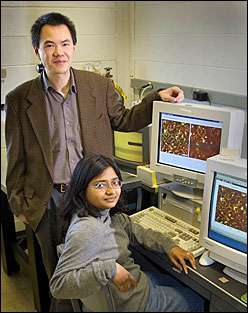Using probes to control chemistry - molecule by molecule

Using probes originally designed to detect and image topographical features on surfaces, scientists at the U.S. Department of Energy's Brookhaven National Laboratory have demonstrated the ability to initiate and spatially localize chemical reactions on the submicron scale. They have been able to reliably manipulate chemistry on a very, very small scale in contrast to normal beaker-type reactions carried out in bulk.
Such "site-selective" chemistry, taken down to the molecule-by-molecule level, could lead to new ways to etch small-scale electronic circuits, the development of extremely sensitive chemical sensors, as well as a better understanding and control of chemical reactions such as those used to convert sunlight into electricity in solar cells.
"Atomic force microscopy (AFM) uses probes that are analogous to the stylus on an old-style record player," says Brookhaven Lab materials scientist Stanislaus S. Wong. However, as opposed to "feeling" the nature of slight variations of pits within record grooves, AFM probes normally detect intermolecular interactions, related to changes in surface chemistry. "What we've demonstrated in our work is the ability to alter the AFM probe so it can be used not just passively, to sense chemistry, but actively, to initiate or control chemical reactions on a surface," Wong said.
In their proof-of-principle experiment, Wong's group attached titanium dioxide nanoparticles to the end of a conventional AFM probe and used it to photocatalytically oxidize selected sites on a thin film of photoreactive dye -- a model for understanding photocatalysis in solar cells. Mandakini Kanungo, a postdoctoral researcher in Wong's lab, will describe this work in a talk at the 231st national meeting of the American Chemical Society (ACS) in Atlanta, Georgia, on Thursday, March 30, 2006.
In the experiment, oxidized and unaffected areas of the dye were often separated by a mere 0.1 microns (millionths of a meter). The hope is to increase the spatial resolution of the technique to affect changes molecule by molecule, or at the one-nanometer (billionths of a meter) scale, Wong says.
Being able to control chemistry at this level has many potential applications. First, it gives the scientists deeper insight into the kinetics of reactions at the molecular level when, for example, a catalyst triggers the in situ oxidation of a chemical in the presence of light. This reaction is important toward understanding how to convert sunlight into useable forms of energy such as electricity. A "close-up" view of the chemistry will allow scientists to experiment with different types of catalyst particles, sizes and shapes of particles, and other characteristics to see precisely how these changes affect the kinetics and other dynamic properties associated with the photocatalytic process. This work could ultimately lead to the design of more efficient catalysts and more efficient solar cells.
In another application, Wong says, "You can use the AFM tip almost like an ultrafine pencil to draw out areas that you would like to react. This creates nanometer-scale 'lines' that are different from the chemistry of surrounding areas on the substrate." In essence, he says, you can etch out such "lines of reactivity," using chemistry to "draw," for example, nanoscale circuits. Such small-scale circuits could further shrink the scale of electronic devices, as well as increase the efficiency and/or speed of data storage and retrieval.
One important benefit of this technique is that it is environmentally friendly, Wong says, using no electric current or potentially harmful reaction conditions. Furthermore, the technique has such high specificity that it offers the potential for single-molecule detection and analysis -- a benefit with possible applications in refined chemical sensor technology. Such sensors might be able to detect as little as a single molecule of a potentially hazardous material released, for example, in a terror attack.
Source: Brookhaven National Laboratory



















